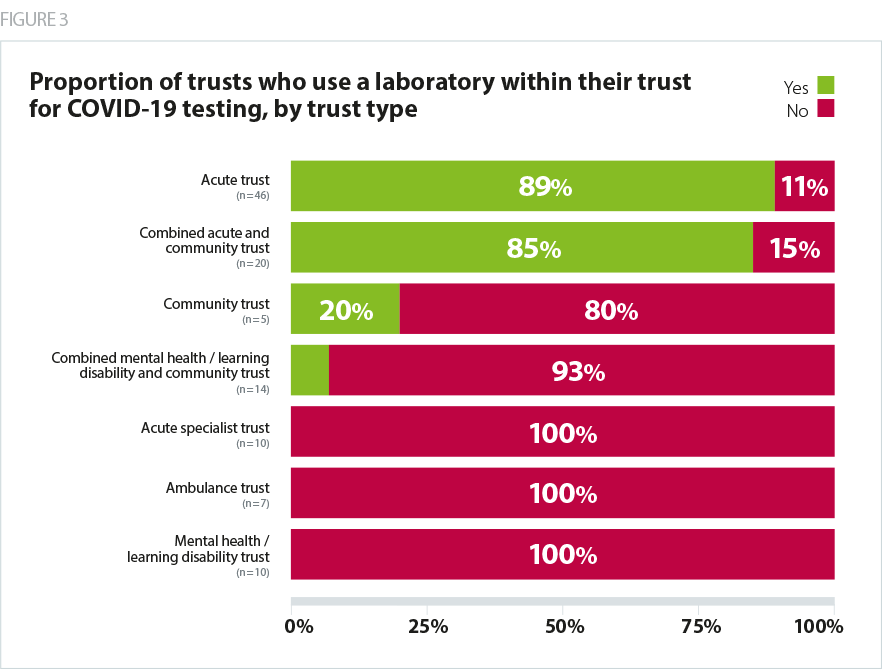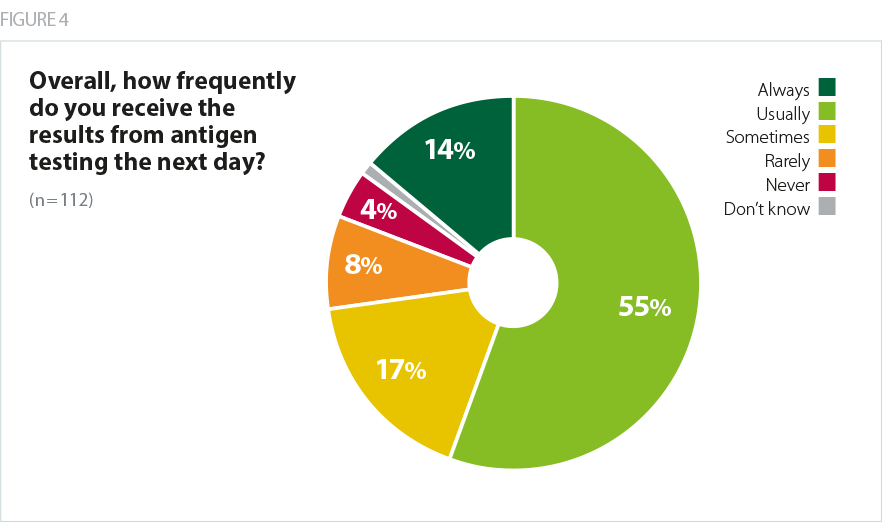Trusts are working hard to provide testing to their communities and are delivering under the current national COVID-19 testing strategy. Significant work has gone into the increase in testing capacity in recent weeks at national, system and local level. Whereas daily tests made available hovered around 100,000 in late April and early May, the number is now routinely more than twice that level (Department of Health and Social Care, June 2020).
Our survey found the vast majority of trusts leaders (83%) are confident in their ability to meet testing requirements under current government guidance - 30% strongly agree they have the capacity to complete all required tests, 52% agree, and only 13% either disagree or strongly disagree. Current guidance prioritises testing for all patients admitted for emergency care, elective procedures, or those discharged to other settings. It requires testing for all symptomatic patients and staff, but not wider testing to identify asymptomatic staff (NHS England and Improvement, June 2020).
Trusts have consistently underlined the importance of fast turnaround times for results within their efforts to deliver effective testing regimes. A high degree of variability in turnaround times between trusts was a theme from our survey, based predominantly on whether trusts have access to on-site laboratories. This speaks to some trusts operating with ‘patchwork quilt’ testing arrangements – putting separate pieces together to form a whole testing programme for patients – as organisations without on-site laboratory access are forced to rely on laboratories at other trusts, lighthouse labs (new diagnostic facilities created in partnership between the Department of Health and Social Care and a number of medtech organisations), as well as other independent facilities.
We asked whether trusts are using one or more of:
- a laboratory within their own trust
- a laboratory at another NHS trust
- lighthouse labs or another independent facility.
Just over half of trusts (54%) said they use a laboratory within their own trust, with most acute trusts (89%) and combined acute and community trusts (85%) being able to do so. Other trust types are far less likely to have this option, with only one community trust and one combined mental health/learning disability and community trust indicating they use a laboratory within their own trust. A significant minority of trusts with their own labs still use other trust labs for testing (40%), but they do so less frequently than using their own facility.

Just over two thirds of trusts (68%) said they use laboratories at other trusts, with a large proportion of these (68%) doing so because they do not have a laboratory within their own trust. This was true for all mental health/learning disability trusts, acute specialist trusts and ambulance trusts who responded to the survey, as well as most combined mental health/learning disability and community trusts (93%) and community trusts (80%).
A small proportion of trusts told us they are using lighthouse labs or other independent testing facilities (18%). In all of these cases this was in addition to either using a lab within their trust or at another NHS trust, and those using this source of testing tended to use it less frequently.
There are some encouraging points looking at overall turnaround times for results, with 70% of trusts telling us they ‘usually’ or ‘always’ receive results the next day. Only one in eight trusts (13%) ‘rarely’ or ‘never’ receive results the next day, indicating an overall picture of efficiency in turnaround times for testing across the country.

However, turnaround times do depend significantly on the ‘source’ of testing for trusts. Whereas over three-quarters (78%) of trusts have an average turnaround time within 24 hours when using on-site laboratories, when trusts use labs in other trusts only 16% report an average turnaround time within 24 hours, and this falls to 10% when using lighthouse labs.
It is clear that mutual aid and strong collaborations between providers is playing a huge part in the national testing effort, though the low take up and variable turnaround times of the much-publicised lighthouse labs is concerning. Access to on-site laboratories is not the only factor influencing turnaround times. Other common reasons identified included transport for off-site tests, a lack of reagents (testing kit material) and lack of staff.
[We have] sufficient capacity based on current guidance and current numbers of admissions. If criteria change then this may become problematic. Similarly, if [the] trust was to take on board testing for primary care/care homes then meeting this requirement would prove challenging.
Acute trust
We have had to adopt 24-hour working and waste time swapping testing onto different platforms due to a shortage in reagents. We need a consistent supply of Cepheid Inc reagents.
Combined Acute and Community trust